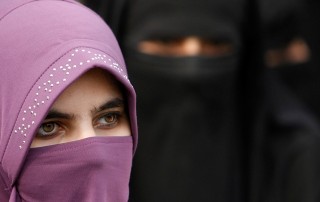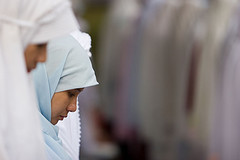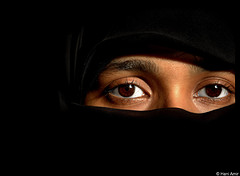Hijab: “Muslim scholars and clerics with dogmatic thinking managed to terrify the Muslim woman into accepting that her hair is –awrah- something like her intimate organs needs to be hidden and covered up”
By Dr. Ashraf Ezzat

Let us agree first that prior to 9/11 the west hardly bothered with Islam or Muslims. But that changed drastically after the terrorist attacks on New York.
People were told that the perpetrators of the planes operation on September, 11, 2001 were all Muslim fundamentalists with lethal anti-west sentiments. History couldn’t have picked a more inappropriate time to introduce Muslims to the world than 9/11 which has in a way stigmatized Islam as the creed of hate and intolerance.
People in America and Europe grew more sensitive to Muslims and their religious practices. For the first time in history nearly 25% of the world population were being judged according to the alleged wrong doing of 19 hijackers. After 9/11 new Arabic words began to find its way into the European and American vocabulary reflecting how much the west has been acquainted with Islam.
People began to be familiar with words like Quran, Sharia law, jihad and of course HIJAB which of all the Muslim teachings and manifestations people in Europe and America felt inclined to make an issue with.
No one was obliged to read or follow neither the Quran nor Sharia, they represented no big deal to most people but that was not the same with HIJAB. Women wearing Hijab were everywhere, you run into them on the streets, in malls and schools. Women dressed up in what seemed more like clerical garb and covering their hair with head scarves and sometimes covering their faces and bodies all together- Niqab– seemed to represent a visual distraction and may be an optical shock- if you want- to modern citizens of the west.
Hijab: why Muslim women wear it
When this phenomenon first began to appear in the last two decades people and specially women in the west asked one question “why would any woman want to hide her hair and face like that?”
Why would any woman want to forsake the modern outfit of today and delve into the close to-medieval wardrobe instead?

Muslim scholars argue that HIJAB is required to wear by all Muslim women according to Quran verses. But first we have to bear in mind that Quran- holy book of Muslims- was revealed piecemeal throughout a period of about 23 years. According to narration, The Prophet Mohamed received the first revelation in 610CE and newer revelations kept on being sent like small messages whenever the circumstances of the newly born Muslim society in the Arab peninsula needed divine guidance. This understanding of the historical aspect of the book is an indispensible prerequisite to discerning the true meaning that lied behind every verse in Quran.
Hijab in scripture and history
Scholars agree that the following verses are mainly the two credible references to the requirement of Hijab in Quran.
“And say to the believing women that they should lower their gaze and guard their modesty; that they should not display their beauty and ornaments except what (must ordinarily) appear thereof; that they should draw their khimar over their bosoms and not display their beauty except to […] “Qur’an 24:31)
“Those who harass believing men and believing women undeservedly, bear (on themselves) a calumny and a grievous sin. O Prophet! Enjoin your wives, your daughters, and the wives of true believers that they should cast their outer garments over their persons (when abroad) That is most convenient, that they may be distinguished and not be harassed. […] (Qur’an 33:58–59)
What most scholars do is interpret those verses literally and neglect the causes of the events behind them and thereby reaching the conclusion that Muslim woman should cover up in Hijab. Muslim clerics and scholars usually miss out on the crucial point that the Quran – like the Bible- is primarily a book of history. You strip away the holy and you will be confronted with a textbook of historical events worthy of our discernment and analysis.
Muslim scholars simply miss out on the fact that sometimes the causes of events are even more interesting than the events themselves. History tells us that back in time when Mohamed called upon Arabs to believe in his divine message, Muslims were a tiny minority ridiculed and persecuted by the elite of the Arab peninsula who thought of Muslims as a bunch of heretic slaves -as slavery was booming at the time.
Mohamed kept thinking of ways to differentiate and distinguish his followers from the nonbelievers. At that time it was customary for women to wear Khimaar-shawl- over their heads but would wear it tied behind so their neck and upper chest were visible.
So the khimar verse came out- telling Muslim women to let it cover the neck and chest instead- to differentiate Muslim women from the non Muslim majority at that time, something that was understood and justified for a minority- that needed differentiation- in conflict with the rest of society.
The historical cause behind the second verses is completely different and rather amusing. The Arabian society- back then- comprised of masters and slaves and they all lived in houses that had no built-in toilets, so going to the toilet meant literally going outside of the house. Slaves were often harassed while on their way to the open air-toilet and since most Muslims were practically slaves at the time, Mohamed cunningly thought it would be safer for Muslim women to dress up in tall draping garments like the free masters of Arabia did so that nobody would harm them. So, thus came the verses that say Muslim women should cast their outer garments over their persons when they are out in the open for that specific purpose.

It is obvious now that the previous cited verses were taken out their historical context. Only in this historical context could we come to understand that wearing veils and long garments are not required by Muslim women in our modern times unlike what most narrow minded Muslim scholars call for.
Muslim women do not need this differentiation any more. It was required of them back then when Islam started, but now all they are required to do is to observe modesty in the way they clothe and behave.
The politics behind the Hijab
20 or 30 years ago few women wore hijab in the Arabic world. It was not a common practice especially amongst young girls and women. Now the majority of women are wearing Hijab and if you accidentally ran into someone – on the street-who was not, then you’d be sure she was a Christian or one of the few left Muslim women with liberal ideas and critical thinking.
It is quite perplexing if you think about it. How come for a society that has been modernized for over a century now-like the Egyptian or the Syrian for example- to relinquish its modern values and adhere once again to the dogmatic values of the past.
Some argue that the Hijab is the traditional outfit of Muslims but that’s not true. Every country in the Arab world has its own folklore and unique traditional clothing. Besides, nobody gets irritated whenever we watch people wearing their traditional outfit like the Japanese, the Indian or the Arabic for that matter but even those mostly welcomed to dress up like the modern woman and modern man of today.
There are socio-political factors at play here behind the extremism and Hijab phenomenon in the Arabic world mainly the incompetence of the educational system which relied primarily on indoctrination and dogmatic thinking, the utter failure of successive corrupt political regimes to improve the living conditions of people and the emergence of a racist Jewish state amidst the Arab Muslim world by means of deception and coercion which helped the sprouting of fundamentalism in Islam
All of those factors caused the revival of Islam movement to flourish and sweep across the Arab world in a clear and serious message that heralds the demise of liberalism and the arrival of Islamists to power in the Arab world.
A grave future awaits those with myopia who think that Hijab or Niqab or even Burqa is all about obeying God’s orders. Hijab is not about covering up the hair; rather it’s about drawing the veil on our minds. Hijab is merely a socio-political sign that tells us that theocracy in Arabic and Muslim countries is just around the corner.

Ashraf Ezzat is an Egyptian born in Cairo and based in Alexandria. He graduated from the faculty of Medicine at Alexandria University.
Keen not to be entirely consumed by the medical profession, Dr. Ezzat invests a lot of his time in research and writing. History of the ancient Near East and of Ancient Egypt has long been an area of special interest to him.
In his writings, he approaches ancient history not as some tales from the remote times but as a causative factor in our existing life; and to him, it’s as relevant and vibrant as the current moment.
In his research and writings, Dr. Ezzat is always on a quest trying to find out why the ancient wisdom had been obstructed and ancient spirituality diminished whereas the Judeo-Christian teachings and faith took hold and prospered.
Dr. Ezzat has written extensively in Arabic tackling many issues and topics in the field of Egyptology and comparative religion. He is the author of Egypt knew no Pharaohs nor Israelites.
He writes regularly at many well-known online websites such as Dissident Voice and What Really Happened.
Dr. Ezzat is also an independent filmmaker. His debut film was back in 2011 The Annals of Egypt Revolution and in 2012 he made Tale of Osiris a short animation for children.
In 2013 his short The Pyramids: story of creation was screened at many international film festivals in Europe. And he is working now on his first documentary “Egypt knew no Pharaohs nor Israelites”.
ATTENTION READERS
We See The World From All Sides and Want YOU To Be Fully InformedIn fact, intentional disinformation is a disgraceful scourge in media today. So to assuage any possible errant incorrect information posted herein, we strongly encourage you to seek corroboration from other non-VT sources before forming an educated opinion.
About VT - Policies & Disclosures - Comment Policy



